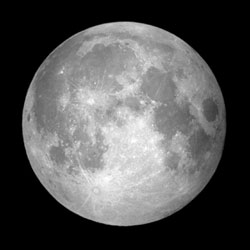
On Thursday, December 15, 2005, the full Moon will be just about at the most northerly declination it can ever attain.
S&T: Rick Fienberg.
When the Moon is full this Thursday, December 15th, go out around midnight and look up. I mean really up. If you live in the world's midnorthern latitudes or farther north, the Moon will be passing just about as close to the zenith as it can ever possibly get.
Moreover, writes J. E. Brown of Los Alamos, NM, "The Moon will rise and set near its extreme northeast and northwest azimuths (unusually far northeast and northwest on the horizon). Look for this at sunset and sunrise," which is when the full Moon rises and sets on the horizon opposite the Sun.
You are seeing the combined effect of two important pieces of celestial mechanics. This year through 2007, they add together to swing the Moon through extraordinarily high and low daily arcs across the sky.
What, exactly, is happening? Hang on and pay attention.
The first and biggest effect is caused by the 23.4° tilt of Earth's equator with respect to our orbit around the Sun. You learned about this part in school. The tilt makes the ecliptic (the apparent path of the Sun) run as much as 23.4° north and south of the celestial equator in our sky. So the Sun, which travels around the ecliptic once a year, sometimes moves high across the sky each day (causing summer) and sometimes low across the sky (causing winter).
Not just the Sun but the Moon and planets also follow the ecliptic fairly closely. So they too ride high across the sky when they are near the ecliptic's far northern declination (in Taurus and Gemini), or low across the sky when they are near the ecliptic's far southern declination (in Sagittarius). This is why the full Moon hangs low on warm summer nights and crosses high on cold winter nights; remember, the full Moon is opposite the Sun.
But there's more. The Moon's orbit around Earth is itself tipped 5° with respect to the ecliptic. The orientation of this tip wheels all around the ecliptic with a period of 18.6 years, a phenomenon known as the regression of the nodes.* During part of the 18.6-year cycle, the two tilts are oriented opposite each other and tend to cancel out; the Moon swings less far north and south in the sky than usual. In other parts of the cycle, the two tilts are oriented the same way and add together; as a result, the Moon in its monthly orbit swings through extremes of high and low declination.
We're in one of those extreme periods from now through 2007. So for Northern Hemisphere residents, the full Moon of June rides remarkably low, the full Moon of December rides remarkably high. Go out and take a look.
----------
* Imagine spinning a CD on edge on a tabletop. Eventually the CD falls and settles toward lying flat. Just before it settles, its surface is wheeling around with a changing orientation just like the Moon's orbit — only a lot faster than once in 18.6 years!
 0
0
Comments
You must be logged in to post a comment.